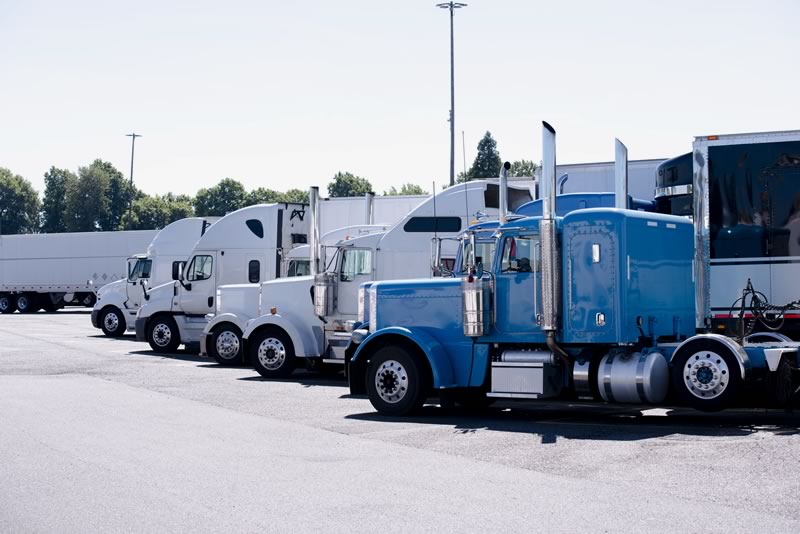
Mar 12, 2020
In today’s market, shipping is a huge factor in the success of a business and the satisfaction of their customers. With consumer’s increasing need for instant gratification, driving the increase in same-day and two-day shipments, an efficient transportation strategy is a necessity—which might seem too overwhelming to take on without assistance. A Transportation Management System, or TMS, is an excellent tool to make sure your product moves efficiently and with good value. Here, we define a TMS and explore the ways that the system is beneficial to the companies that employ it. (more…)

Mar 2, 2020
What are NMFC Codes and Why are They Important?
National Motor Freight Classification (NMFC) Codes were created by the National Motor Freight Traffic Association to classify all commodities into distinct classes, guaranteeing fair measures and standardized pricing. There are currently 18 different classes between 50 and 500. Below, we detail the criteria for each class and why it is imperative that the NMFC Codes are followed to the T. (more…)

Feb 26, 2020
Ensuring that you select the right carrier to meet your needs without overcharging can be a painstaking and time-taking process—but the energy you devote to finding the perfect carrier will pay off in the long run. Below, we have accumulated the best tips on negotiating with potential carriers in order to get the right shipping rates for your company.
Leverage your shipping volume and freight association
In general, a larger shipping volume will grant better freight quotes, but low volumes can still fetch some desirable numbers. Don’t forget that a carrier wants to do business; they want their trucks and planes to be full and they want to avoid wasting empty space. Consider using a transportation management system to find accurate shipping volumes. You never know what size will be appealing to a carrier.
You can also leverage freight associations if you are shipping small items, which will help you get affordable group buying prices. Double check any associations you currently have a membership with, and if you don’t have any, you may want to look into joining an association purely for the savings.
Explore your options
Don’t feel locked down to a mode you used in the past or think will be best for your business. Different modal options might decrease prices in surprising ways. Modes like Parcels, Truckloads, Intermodal, Ocean, and Air might have hidden pros and cons that cause one to stand out as the most cost-effective.
Only pay for what you need
What is important to your company, and what is unnecessary? Freights may offer benefits that just aren’t going to help you reach the objectives you set out to reach, and that’s okay. In fact, you can use this to your benefit. If you don’t need the speed of shipment they’re offering, compromise on a slower time for a lower rate. Decide what is and isn’t important to you, tell your carrier, and craft a contract that meets all your needs and puts the benefits you don’t want into something more important.
Remember the volatility of pricing
Prices are volatile. Don’t put your trust in estimates that change depending on the season or particular instances and problems. Rates can rise with special issue on cargo ships or fall with peak seasons. Anticipate nuances and readjust your expectations.
Don’t jump at the first offer
Fuel and accessory charges, freight rates, and other costs can usually be negotiated. Even if your first offer is an attractive one, it is likely that there is a little wiggle room to lower the costs.
Don’t shy away from signing contracts with multiple carriers, either. Comparing rates between carriers is where you’ll find the biggest wealth of information on what is most affordable (and most logical) for your company. it is possible to renegotiate with carriers after seeing all the offers, even if you already have a contract.
Moreover, it may be beneficial to look for ways that you can benefit the carrier, rather than the carrier just benefitting you. Do you have the ability to pay faster than they recommend? Is there something about your business that will make their job easier, or perhaps reduce their costs? Those factors can be used in your favor to get lower rates.
That said, remember to balance negotiation and relationship. If you end up doing business with a carrier, you’re going to want a positive relationship for now and the future. Don’t make unreasonable demands, and don’t refuse to bend to their requests as they bend to yours.
Honesty is key
You might be tempted to pad your numbers in order to get a better rate, but oftentimes companies who don’t meet the shipping volume they initially proposed will be charged hidden fees. Be honest with your shipping volume. Even better, make it clear in your RFP that you are not making any volume commitments.
Confess to carriers that you are exploring other options—the competition can often prompt them to lower their rates in order to be your top choice. If you’re using a TMS that sorts your carriers by lowest cost, let them know, especially if they aren’t the lowest on the list.
Also check that you have read the fine print and know everything a carrier is coming at you with. Hidden fees and inflexibilities are not things you want to worry about after doing business together for a quarter. That initial quote that sounded so good when you first heard it might be laden with issues you need to bring to the surface and negotiate.
Craft a Master Agreement
A Carrier Master Agreement can be one of your biggest tools in making sure you get what you need. This agreement is private between you and your carrier. It solidifies everything you discussed on paper, and it isn’t seen by the carrier’s entire shipper base.
Confirm the carrier that the Master Agreement will take precedence over their tariff. That way, the points you worked hard to negotiate in the agreement don’t go to waste by another document they hold in higher esteem.
Shipping can be complicated and costly. Luckily, shipping rates aren’t written in stone—they are malleable with the current market climate and the individual needs of a company. Take the time to negotiate with your carrier in order to strike an optimal deal for both parties involved.
Feb 17, 2020
Lots of focus goes into the logistics inside a distribution or manufacturing center, which often leaves transportation strategies out of sight and out of mind. Transportation is a vital cog in the wheel, determining how your product gets to the customer, and ultimately, the end-user. How can you form a transportation strategy that maintains the efficiency and cost-effectiveness you’ve prioritized within the walls of the manufacturing center? Below are a few guidelines to help you meet your desired outcomes and KPIs.
Start with your key objectives
What is your biggest priority in the realm of transportation? Defining your objectives is vital to fully develop a strategy that meets your company’s specific needs. Below are a few different objectives a business might choose to focus on:
- Improve on-time deliveries
- Reduce freight and carrying costs
- Improve visibility in the process
- Reduce handling and damage
- Improve relationships with vendors
- Reduce purchasing lead times
- Reduce carbon footprint and put a focus on sustainability
Make the big decisions
Now that you know the angle you want to approach from, you can make the most important decisions that will cause the most dramatic changes to your transportation strategy. The biggest decision any company can make is whether they should manage their own transportation or put it in the hands of a fleet. Would relying on another resource help you reach your goal? Or would it complicate a system you feel you can fine-tune to reach desired results? Choosing who takes care of transportation is the biggest decision in optimizing how transportation will take place.
You might find that this isn’t a decision you need to make—you may have already seen the need to hire a fleet, or you are clear that a fleet wouldn’t solve your problems. Think about what other big-picture questions might need a little attention. Are your current transportation assets the most efficient for your needs? Will you have to make a big financial shift to optimize transportation for your company? Consider what decisions will impact the most people and require the most resources.
Answer the less dramatic questions
With the big picture out of the way, the smaller (but still very important) details can get the attention they need. Once again, your corporation should ask introspective questions to get on the same page, decide the numbers and results you want to see, and tweak your strategy in order to see them. Here is another brief list of questions for consideration:
- How frequently do you need to ship and make deliveries?
- Are there minimum shipping orders?
- How far away from the distribution center are you willing to ship?
Let modern means assist you
You don’t have to crunch the numbers by hand and make all the decisions on your own. There is freight optimization software you can leverage that models a company’s shipments in order to see strengths and weaknesses clearly and create according solutions for specific customers.
Don’t lose sight of the warehouse
It might seem counterintuitive to focus your energy on warehouse efficiency while trying to improve transportation, but both aspects of the process need to be working smoothly in order for one to reach its highest potential. Ensuring that your in-house resources are being properly utilized and that you are at warehouse capacity is vital to meeting fulfillment requirements. Streamlining the flow inbound and through manufacturing can solve some logistical issues you may have blamed on inefficient transportation. Predictability is beneficial to your company’s carrier sourcing as well.
Set a benchmark and track the changes
Your current metrics are the starting point. Use them as a benchmark to measure the changes you see after implementing an updated transportation strategy. If you are seeing no improvement at all from your benchmark, or even a regression, consider whether you focused on the right key objectives at the start. If you are seeing a marginal improvement but hoped for a more drastic difference, consider the changes you might have thought weren’t necessary to make, or whether you didn’t make changes in a big enough degree to get the results you want.
Again, evaluating your success in comparison to past results is a great time to use freight optimization software. It can help you find minor changes that can make big impacts in cost, efficiency, and visibility.
Further, continuous improvement should be a pillar of your transportation strategy. Change is not made once to provide an infinitely successful system; it’s made over and over again to keep up with new technology and meet ever-changing needs. Keep record of where you started and how you’ve improved over time will help your transportation strategy evolve when needed. Document your entire strategy and share it with management—no effective changes will come if the process isn’t properly recorded and monitored by all involved.
Revamping your transportation strategy can improve your company’s business practices and relationships with vendors. Whether you are hoping to decrease overall costs or increase on-time and efficient deliveries, a more transparent and streamlined transportation strategy can help you reach multiple goals in a single stride.
Jan 27, 2020
In the trucking and transportation industry, providing optimal customer service is seldom at the top of a company’s priorities. And it shows. While the bar may be low, however, simply being better than the next guy in an industry not reputed for great customer service is not enough. You have to do more to stand out. Indeed, Berger does more to exceed its customer’s expectations because it values its customers and, likewise, it values the quality service it provides to them.
Attention To Customer Feedback Improves Customer Care
By providing better treatment to our customers, our customers happily return the same. Whether it is in the form of social media ratings, word-of-mouth recommendations, or honest feedback that helps Berger improve its awareness of consumer needs, good customer service is proven to benefit all parties involved.
Being attentive to customer complaints and responsive in the event of delivery issues might be enough to keep the positive customer reviews coming and to hold negative feedback at bay, but that is not a true reflection of the incidence of delivery problems or other failures of service. Berger goes above and beyond making an effort to satisfy its customers over the competition, in part by internalizing and analyzing consumer issues and using the results of those assessments to improve service across transport processes. Overall, providing superior customer service helps Berger be a better transportation company.
Berger Recognizes The Real-World Cost Of Failing To Deliver
Berger is a business run by people who care about people. Aside from inventory availability, transportation is the most critical stage in the consumer consumption model. If Berger fails to perform its services to the best of its abilities, the customers are at risk of not having some very important needs met. Without assuming undue self-importance, Berger understands that a failure in delivery could mean the difference between life and death for some consumers, and Berger encourages all of its employees to treat every delivery with such care. For example, the recent scheduled blackouts in California resulted in local stores quickly selling out of personal generators and online orders to skyrocket. Victims of these power outages face days and even weeks without the means to power their cell phones, operate their home security systems, or keep food and medication cold long enough for safe consumption. Likewise, the increased demand for home-delivered medication places added import on timely and reliable delivery scheduling, and Berger is diligent in doing its part to meet these customer’s health and wellness needs.
Data Analytics Requires Transparency In Service
With advances in data analytics and the ever-expanding breadth of its applications, the transportation industry can expect to see company service records thrust into the public eye in a whole new way. Historically, transport-tracking businesses have had to manage public perception in light of the ease of making online customers reviews. These reviews are inherently biased and likely do not depict a fair sampling of customer experiences for any given company. Whether the average reported opinion is positive or not, at the end of the day, it is just that: opinion. Such a review represents a perspective based on the sum of a customer’s experience with the business and, significantly, not reflective of how the business actually performed the service it was hired to execute. In the near future, this will change thanks to third-party data tracking.
In the near term, increased importance will be placed on data analytics in the trucking industry because service metrics are expected to be made public in the coming years. Third-party monitored and reported data metrics concerning a transport company’s service record will not only affect potential new customers and partners who are unaware of word-of-mouth or written consumer reviews but will also stand in contrast or comparison to publicly reported consumer opinion.
So, just being better on the surface won’t matter as much going forward—actual execution will matter more than satisfying a dissatisfied customer after the fact because the negative data points from the original failure to execute as promised is what gets recorded and tallied into the company’s public report card. Berger wants to do more than just look better, we want to be better. It is important to us that our customer feedback matches the objective, third-party analytics that prove the quality and fidelity of our services.
As an industry leader, Berger appreciates that it is a role model and that its practices—including and especially its customer service practices—set an example for companies offering the same or comparable services. Berger welcomes this responsibility as extra motivation to set the highest industry standards by exceeding its own service goals and surpassing customer expectations.



